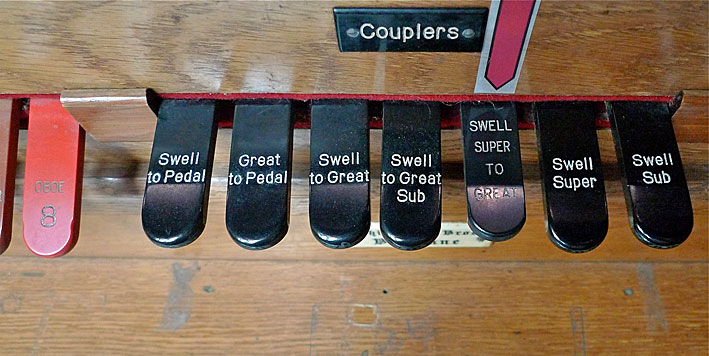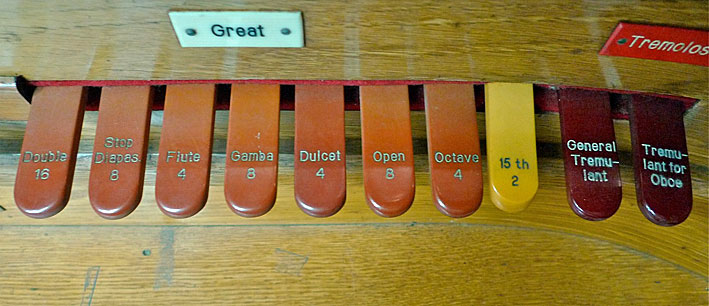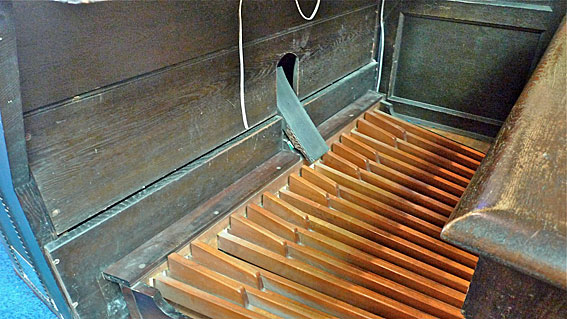St Andrew's Seventh-Day Adventist Church
(formerly Presbyterian, and subsequently Uniting Church)
Maryborough Street, Bundaberg
Whitehouse Bros, Brisbane, 1932
Addition 1986 David Hudd
2 manuals, 5 ranks extended, electro-pneumatic action

St Andrew's Seventh-Day Adventist Church
(formerly Presbyterian), Bundaberg
[Photograph by Trevor Bunning (November 2010)]
Historical and Technical Documentation by Geoffrey Cox
© OHTA 2011, 2016 (last updated November 2016)
The Presbyterian congregation in Bundaberg was constituted in 1881, and the first church on this site was built in 1882. The foundation stone of the present church was laid in 1931, the jubilee year of the congregation, and it was opened in 1932. This fine ecclesiatical building, dominated by a massive square carillon tower, was designed by the architect, Lange L. Powell of Messrs Powell and Rae, Brisbane.1 Other notable Queensland buildings designed by Powell include the Masonic Temple and St Martin's Hospital in Brisbane, and Holy Trinity Anglican Church, Mackay. The congregation joined the Uniting Church in the 1970s, and the building was sold to the Seventh-Day Adventist Church in 2004.
The organ was completed by Whitehouse Bros at a cost of £1262.14.0, in time for the dedication of the new building on Saturday 3 September 1932. Along with the carillon, the instrument was donated by the Pierson family in memory of their parents.2 It comprises five ranks of pipes extended over two manuals and pedals with electro-pneumatic action, with the pipework entirely enclosed in a swell box hidden behind a screen at the front of the church.


Interior of St Andrew's Church, Bundaberg
[Photographs by Trevor Bunning (November 2010)]
This was the first Whitehouse instrument built with electro-pneumatic action, and their first extension organ. Its landmark significance was heralded proudly in the Bundaberg press immediately prior to the official opening:
NEW ORGAN
ST. ANDREW'S CHURCH
__________
Electrically Controlled
__________
The name of Whitehouse Bros. has always been in the forefront of the organ world. The recent installation at the new Presbyterian Church is claimed to be the first all-electric organ built in Australia, and Bundaberg should be proud of having such an instrument in the city.
Representatives of "The Times" were cordially received by the managing director of the firm of Whitehouse Bros. (Mr. J. H. Whitehouse) and his son (Mr. J. Whitehouse), who directs the special department dealing with electric organs, and were conducted through the instrument.
First of all comes the console, the only part of the organ actually in view (the main organ itself being hidden by a beautiful screen). This console is in itself a beautiful piece of work, being fitted with all the latest forms of controls, all easy to handle, and responding to the slightest touch of the fingers. The blowing room is situated under the main organ chamber. In the organ chamber there are hundreds of pipes, and when Mr. Whitehouse pointed the smallest out, one inch and a half long and one-quarter of an inch in diameter, and the largest, 1ft. 6in. square and 10ft. long, the problem of the different tones was solved.
Mr. Whitehouse then opened some of the action parts, showing the number of contacts too numerous to mention, which at first sight resembled the inside of an automatic telephone exchange. This was the first Whitehouse instrument built with electro-pneumatic action, and also their first extension organ.3
Influences for these developments may be identified in the involvement of the Whitehouse firm with the use of electro-pneumatic action in the rebuilding of the Willis organ in the Brisbane City Hall in 1927-29, and in maintaining the two Wurlitzer theatre organs installed in Brisbane in the 1920s using electric action at the Wintergarden Theatre and the Regent Theatre. The St Andrew's instrument retains its original horseshoe-type theatre-organ console, with Wurlitzer-type stop tongues. In the Whitehouse opus list, it was soon followed in 1933 by similar instruments at Holy Rosary Catholic Church, Bundaberg and the Presbyterian Church, Ithaca. These were followed in turn by others for Paling & Co., Sydney (now at St James' Catholic Church, Forest Lodge, NSW) (1934), St Patrick's Catholic Cathedral, Toowoomba (1935) and the New England Girls' School, Armidale (1936).

1932 Whitehouse console at St Andrew's Church, Bundaberg
[Photograph by Trevor Bunning (November 2010)]
Two days after the dedication of the new church, the organ was officially opened on Monday 5 September with an organ recital by Mr Archie Day, F.T.C.L., at that time 'deputy organist for the City of Brisbane, and organist of the Ann Street Presbyterian Church'. The organ works performed were Grand Offertoire in D by Batiste, Andante Cantabile by Tschaikowsky, Allegretto by Wolstenholme, Prière et Berceuse by Guilmant (by special request), 'Now thank we all our God' by Karg-Elert, and the complete Suite Gothique by Boellmann. Assisting artists were Mrs R.N. Robertson (soprano), Mrs R. Mungomery and Miss Nellie Clement (violinists) and Miss Elsie Stewart (contralto), who performed works by Elgar, Gounod and Windsor. The church choir sang Mozart's Gloria from the Twelfth Mass under the direction of Mr. C. Dunkley, with Mr R.H. Ingram at the organ.4
The organ has remained largely as it was built originally, although there have been a few minor changes: Whitehouse Bros installed a new mechanical action to the swell pedal in August 1939,5 and a further extension to the Principal rank (Great Fifteenth 2ft) was provided by David Hudd in 1986.6
GREAT |
|
|
General tremulant
Tremulant for Oboe
Electo-pneumatic action
Compass: 61/30
3 thumb pistons to Swell
3 thumb pistons to Great
Balanced swell pedal
Pedalboard: radiating & concave.7
________________________________________________________________________
1 Richard Bardon, The Centenary History of the Presbyterian Church of Queensland, 1849-1949 (Brisbane: W.R. Smith & Paterson, 1949), pp. 220-21; Bundaberg Daily News and Mail (3 September 1932), p. 2 & (5 September 1932), p. 6; Bundaberg Daily Times (3 September 1932), pp. 10-11, 6; Queensland Heritage Council, Queensland Heritage Register, location 602489.
2 Whitehouse Bros Ledger (1922-1940), pp. 581-82, 575, 543, 153; Bundaberg Daily Times (3 September 1932), p. 11; Bundaberg Daily News and Mail (5 September 1932) p. 6.
3 Bundaberg Daily Times (2 September 1932) p. 4.
4 Bundaberg Daily Times (6 September 1932), p. 3; Bundaberg Daily News and Mail (6 September 1932) p. 2.
5 Whitehouse Bros Ledger (1922-1940), p. 153.
6 Personal communication to G. Cox from David Hudd, late 1980s.
7 Specification noted by G. Cox, 1974.







[Photographs by Trevor Bunning (November 2010)]